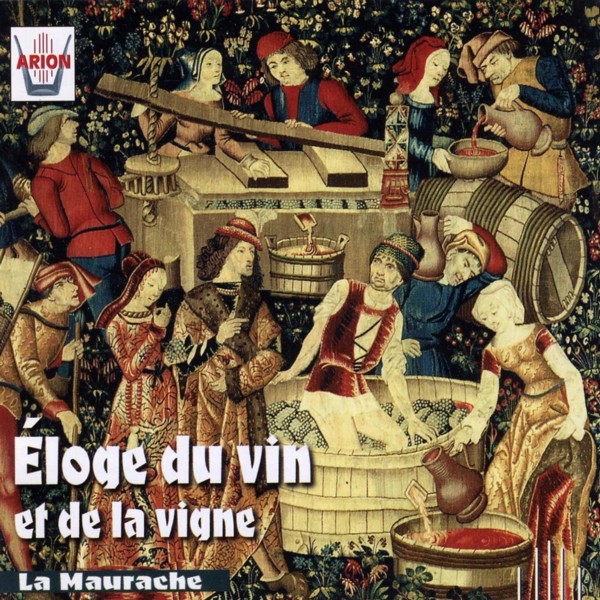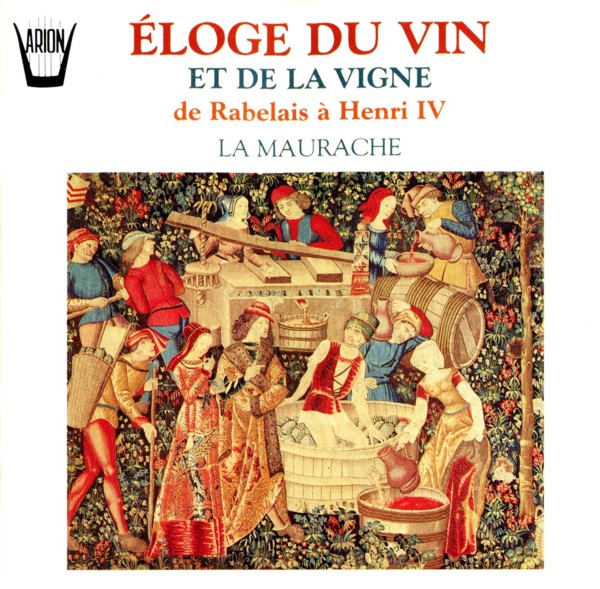
medieval.org
lamaurache.free.fr
Arion ARN 68248
1993

medieval.org
lamaurache.free.fr
Arion ARN 68248
1993
1. BON VIN DOIT [1:28]
Motet-conduit. Anonyme, Roman de Fauvel (fin XIVe s.)
soprano, mezzo-soprano, trois voix d'hommes, bombarde ténor, viole, régale
2. BON JOUR, BON MOIS [2:08]
chanson de quête. Guillaume DUFAY (v. 1400-1474)
soprano, ténor, flûtes soprano et ténor, viole, luth
3. SUITE DE DANSES ITALIENNES [2:58]
a) La Gelosia (bransle ?)
b) Amoroso (ballo francese). Giovanni AMBROSIO (fin XVe s.)
c) Saltarello. Domenico ANELLO (fin XVe s.)
dessus de viole, deux bombardes, luth, percussion
4. ADIEU CES BONS VINS DE LANNOYS [3:29]
Virelai. Guillaume DUFAY
mezzo-soprano, flûte a bec, vièle, viole, luth
5. BEVONS MA COMMÈRE [1:45]
Bransle simple. Manuscrit de Bayeux (fin XVe s.), Chanson XV
soprano, mezzo-soprano, ténor, basse, flûte sopranino, flûte soprano, viole, luth, percussion
6. BON VIN JE NE TE PUIS LAISSER [3:32]
Basse-dance. Manuscrit de Bayeux, Chanson XLIII
basse, bombarde alto, dulciane basse, régale, vièle
7. FU TEMPO GIÀ [2:18]
Loyset COMPÈRE (1450-1518)
chalemie, dessus de viole, bombarde ténor, basse de viole, luth, clavecin
8. TENEZ CES FOLS EN JO¨YE [3:12]
sotte-chanson. Manuscrit de Bayeux, Chanson XI
trois voix d'hommes a cappella
9. OY COMAMOS Y BEBAMOS [1:11]
Juan del ENCINA (1469-1529)
orgue régale, darbouka
10. QUAND JE BOIS DU VON CLARET [1:14]
anonyme (1541 / Restitution Aimé Agnel)
soprano, mezzo-soprano, basse
11. TRUT AVANT ! IL FAUT BOIRE [1:32]
Jean RICHAFORT (d. 1548 / Restitution Georges Dottin)
trois voix d'hommes, bombarde alto, régale, percussion
12. SANSSERRE [1:49]
basse-dance. Pierre ATTAINGNANT († 1552)
luth, flûte alto, basse de viole
13. BLANC ET CLAIRET [2:00]
anonyme (publié par Pierre ATTAINGNANT)
soprano, mezzo-soprano, basse, flûtes ténor et basse, violes ténor et basse, luth, clavecin
14. HAU LE BOYS [1:41]
anonyme (publié par Pierre ATTAINGNANT)
quatuor vocal, deux dulcianes, luth, régale
15. SUITE INSTRUMENTALE [4:55]
Pierre ATTAINGNANT
a) La Magdalena, basse-dance
b) Recoupe
flûtes alto et ténor, dessus et basse de viole, luth, clavecin, percussion
c) Tourdion "Quand je bois du vin clairet" — Texte du Tourdion : César Geoffray
Quatuor vocal, deux cromomes, viole, vihuela, régale, percussion
16. VIGNON, VIGNETTE [5:33]
Claudin de SERMISY (v. 1490-1562)
a) Pièce au luth. Luis MILÁN († 1561)
b) Chanson
Quatuor vocal, deux cromomes, basse de viole, luth, clavecin, percussion
c) Variation à la basse de viole
instruments seuls
d) Pièce au clavecin. Pierre ATTAINGNANT
17. TRINK ICH WEIN, SO VERDERB ICH [1:00]
Henning DEDEKIND (1588-1628)
régale, trois comornes, luth
18. LÀ, LÀ MAÎSTRE PIERRE [1:36]
Jhan GERO (XVIe s.)
soprano, mezzo-soprano a cappella
19. NOUS BOIRONS DU VIN CLAIRET [1:22]
Jacob ARCADELT († v. 1560)
ténor, basse, deux cromomes, régale, percussion
20. COURANTE [1:39]
d'après Thoinot ARBEAU (Orchésographie, 1588)
deux dulcianes basse, ténor et basse de viole, luth, clavecin
21. O VIN EN VIGNE [1:34]
Roland de LASSUS (1531-1594)
soprano solo, quatuor vocal, clavecin, basse de viole
22. JE GAGE DE BOIRE AUTANT QU'UN SUISSE [1:17]
chanson transcrite au théorbe par Robert de Visée (v. 1650-v. 1725)
23. QUI VEUT CHASSER UNE MIGRAINE [2:40]
Gabriel BATAILLE (v. 1575-1630)
basse solo et quatuor vocal, théorbe
24. SUR LA MER [1:50]
d'après Jacques MANGEANT (début XVIIe s.)
quatuor vocal, deux flûtes a bec, basse de viole, luth, clavecin
25. DONNEZ A BOIRE [1:31]
canon. Thomas RAVENSCROFT (1590-1633)
quatuor vocal, deux flûtes a bec, basse de viole, luth, régale, percussion
10 : Restitution Aimé Agnel
11 : Restitution Georges Dottin
3, 5, 6, 8, 16c, 20, 23 (refrain), 24 : Harmonisations de Julien Skowron
19 : Texte additionnel—couplets 2 et 3 (d'après des chansons à boire du 16e s.) de Julien Skowron
Arrangements, orchestrations : Julien Skowron et les musiciens de LA MAURACHE
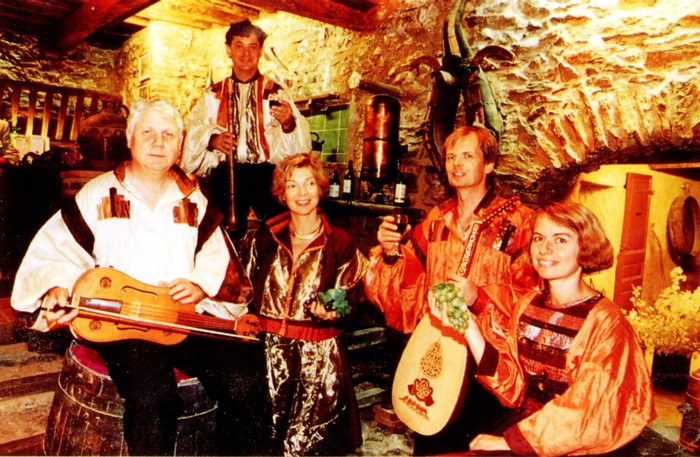
LA MAURACHE, voix et instruments anciens
Réalisation musicale : JULIEN SKOWRON
Laurence ORLOWSKI, soprano
Anne Carole DENÈS, mezzo-soprano
Hervé BARREAU, flûtes à bec, cromomes, chalemie, bombarde, dulciane, darbouka, voix
Kléber BESSON, luths, vihuela, théorbe
Julien SKOWRON, ténor dessus et ténor de viole, vièle à archet, cromorne
Musiciens supplémentaires, invités à participer au présent enregistrement:
Vincent LECORNIER, basse
Muriel ALLIN, viole de gambe (basse)
Alexandre-Pierre LEVY, clavecin, orgue régale, tambourin
Michèle VANDENBROUQUE, flûtes à bec, cromome, chalemie, bombardes, dulcianes
Nicolas ZANLONGHI, percussions : tambours, tambourins, darbouka, naquaires, bendhir...
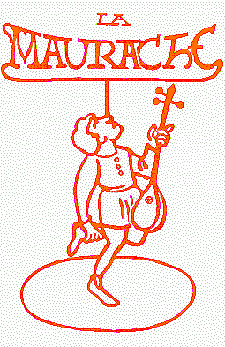 LA MAURACHE is an ensemble which specialises in the interpretation of
the music of the Middles Ages and of the Renaissance. The ensemble
endeavours to demonstrate the universal value, the «classicism» and the
timelessness of this «Early» music, without limiting themselves to these
periods. The importance of their recent musicological discoveries and
the creative freedom of their musicians have led to the revival of the
rich, varied and colourful repertoire of seven centuries of western
music.
LA MAURACHE is an ensemble which specialises in the interpretation of
the music of the Middles Ages and of the Renaissance. The ensemble
endeavours to demonstrate the universal value, the «classicism» and the
timelessness of this «Early» music, without limiting themselves to these
periods. The importance of their recent musicological discoveries and
the creative freedom of their musicians have led to the revival of the
rich, varied and colourful repertoire of seven centuries of western
music.
Recognised by the Ministry of Education, and since 1982 regularly commissioned by
the
Direction de la Musique et de la Danse at the Ministry of Culture and
Communication to carry out «Musical Missions», this ensemble works in
close collaboration with the Associations Départementales pour le
Développement de la Musique et de la Danse (ADDM, ADIAM...)
The
instruments used by LA MAURACHE are faithful reconstitutions from period
documents or traditional instruments. The Moorish guitar or «Lute
Maurache« is an instrument which was imported to Europe by the Arabs
during their invasions, or brought back by the Crusades. It is mentioned
in the XlVth century by Guillaume de Machaut in his «Dits«. This
instrument has been adopted for the title of the ensemble.
Since
1978 when the ensemble was formed, LA MAURACHE has taken part in many
concerts, shows and radio and television programmes (including «La
Chambre des Dames», TF1/SFP) in France and abroad. The ensemble has made
several recordings released on the ARION label.
Le présent enregistrement a été réalisé grâce à l'aide de l'ADIAM 92 et de l'ADIAM 77
Recto : Tapisserie "Les vendanges" (16e s., France, Musée de Cluny / © Photo R.M.N.)
Illustrations reproduites p. 2 et p. 15 avec l'aimable autorisation des Editions Edita Lausanne (Le Grand Livre du Vin, © 1982)
Prise de son et direction artistique : JEAN-MARC LAISNÉ
Montage numérique : EMMANUEL VAILLANT (Studio Résonance)
Enregistrement réalisé en Juillet 1993 en l'église de Choisel
℗ ARION 1993
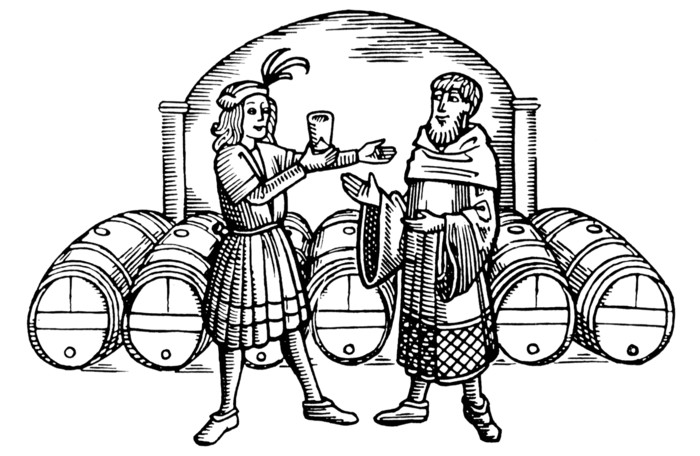
Since the very beginning of our western civilization, the history of
MUSIC and the history of WINE have been very closely linked. The
consumers of the one — the Church, kings and lords, the upper and lower
middle classes, and, more recently, good, ordinary simple folk — also
consume the other.
The importance of Franco-Flemish music in the
15th and 16th centuries is well-known; it went hand in hand with the
importance given to wine in the countries of northern Europe during the
same period: Bordeaux belonged to the English until 1453; for a long
time, Flanders and Burgundy formed a single state; from 1579, Holland
was the country of the greatest wine merchants (1). The Franco-Flemish
composed numerous songs about wine and the vine.
In France (and
elsewhere), humanism — that great intellectual movement that formed the
inspiration and basis of Renaissance culture — developed in the 16th
century.
François Rabelais (1494-1553) was one of its great
initiators and propagators. His works are brimming with optimism, joie
de vivre, moral and physical vitality, and WINE and MUSIC play an
important role. In Gargantua, Chapter V, entitled "Les propos des bien yvres", Rabelais praises "le bien boyre" — good drinking— and wine:
"— Some white wine! Pour it out, pour it, be damned! Pour and give me plenty: my tongue is peeling [with thirst]. [...]
— Oh, lovely white wine!"
And further on, in Chapter XXVII, the monk Frère Jean des Entommeurs vigorously defends the wine of his abbey:
"[...]
You yourself, Sir Prior, like to drink of the best. Like any great man,
a man of noble birth is never impartial to good wine."
As for music, it plays a most enviable role in young Gargantua's education (— a music teacher's dream!...):
"Afterwards,
he let himself go, singing musically in four or five parts, or upon a
theme, to his throat's content. As for musical instruments, he learned
to play the lute, the spinet, the harp, the transverse flute and the
flute with nine holes, the viol and the sackbut..." (Chapter XXIII).
The allusions to wine and music in the works of Rabelais are innumerable: we could go on quoting them ad infinitum.
***
If "all
the peoples who are familiar with wine have celebrated its merits...
the Mediterraneans have been able to freely take advantage of the
benefits of vivis vinifera... Christ himself made it a symbol
of life and communion, thus opening up the way for the countless
Christian writers who have sung the praises of the Divine Nectar in
their works"(1).
It is, in turn a "source of vigour", a "ferment of friendship", is a "love potion", an "invitation to forgetfulness" ; it is a basic element of "human nourishment": Après le pain, vient le vin" — "After bread, comes wine" (Olivier de Serre, 1600). It has "hygienic, medicinal, dietary and therapeutical properties."...
(It is said that the inhabitants of Mèdoc, which produces the best
growths of claret, head the list for records of human longevity in
France, and that champagne makes convalescents see everything through
rose-tinted spectacles.) It is also a "magic or religious symbol", a "source of artistic inspiration", a "sign of civilization". It enables man to "surpass himself", if only in a certain fleeting, salutary intoxication.
For a long time, however, wine was also the privelege of the ruling classes and it is still a "commodity with a high commercial value", and has often been used in "trading", thus facilitating contacts between men and civilizations. "Last but not least, it is one of the few things that improve with age, sometimes attaining to the sublime...." (1)
"Wine is very closely linked to the origins of our civilization: it is one of its most sumptuous, most pacific treasures." (Géo H. Blanc) (1)
All
these merits, all these virtues of the vine and wine are already to be
found recognized and exploited in the poems and songs of the
Renaissance. That priveleged period, which saw the flourishing of
humanism, gave rise to an abundance of painters, poets and musicians,
who joined in this generalized praise of the "Divin Jus de la treille"
(Heavenly juice of the vine).
The musicians of LA MAURACHE,
overcome with good joyful, wholesome intoxication, have chosen to
illustrate that period through this recording, entitled "IN PRAISE OF
WINE AND THE VINE", comprising songs and dances from the time of
Rabelais (late 15th century) to that of Henri IV (early 17th century) —
the latter, so we are told, was fed on Jurançon wine from infancy...
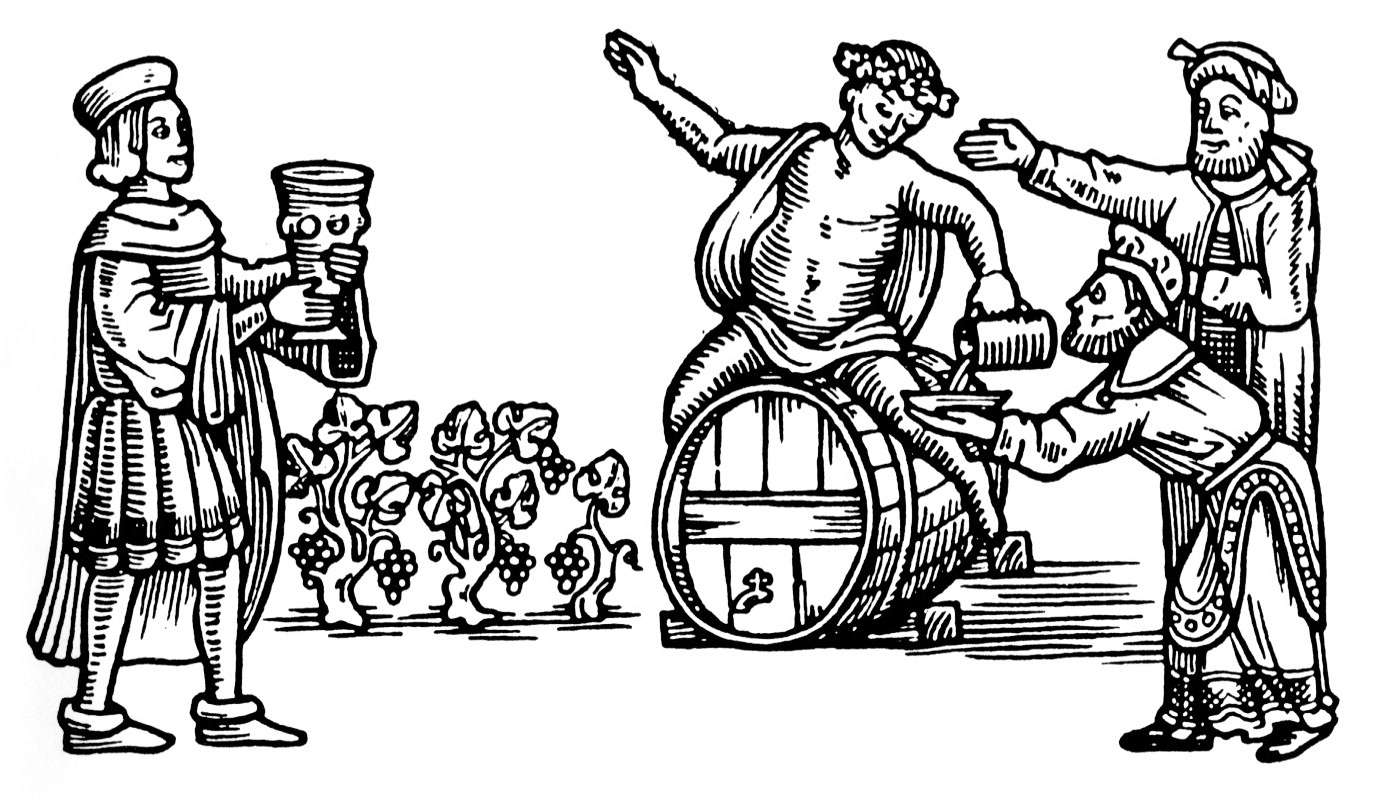
I. FIRST OF ALL, LET US TASTE...
...a conductus motet from Le Roman de Fauvel:
• Bon vin doit
[1], in which we hear, successively, the tenor, altus and then
discantus singing of wine, each to a different text, in French (most of
the polyphonic pieces in Le Roman de Fauvel are in Latin).
This will be followed by two songs by Guillaume Dufay (c.1400-1474): a collecting song,
• Bon jour, bon mois [2], with a very brief allusion to wine, and
• Adieu ces bons vins de Lannoys
[4], a piece dated 1426, full of nostalgia and melancholy regrets,
probably written on the composer's departure from Picardy for Italy. We
cannot say for certain whether "Lannoys" is a reference to Lannois (the
region around Laon), where important vineyards existed until the recent
past, or to the small town of Lannoy (near Lille), where there were
apparently vines until the 15th century (2).
Between these two songs, we
have the pleasure of a
• Suite of three Italian dances [3],: one similar to a branle (La Gelosia), a pavan, Amoroso (ballo francese) and a Saltarello.
As accompaniment, we recommend a fresh, light Muscadet...
II. THEN WE SHALL SAMPLE...
... three songs from the Bayeux Manuscript (late 15th, early 16th century).
• Song XV, Bevons ma commère [5] is in the form of a branle simple.
• Song XLIII, Bon vin je ne te puis laisser [6] it is a love song addressed to wine, here treated as an irregular basse danse. And
• Song XI, Tenez ces fols en Joÿe
[8] is a "sotte-chanson" ("silly song"), the melody of which is
reminiscent of the first tone in Gregorain chant (D-A, A-C). It is
perhaps a "composition by one of those thirsty clerics who spent their
time in the taverns" (3), and who amused themselves in the refrains by
using, for their comical effect, onomatopoeic expressions usually
intended to urge on draught animals — for example, Anne Hauvoy! and Et Hoÿe!
(According to grammarians of the time, "Hoÿe" was pronounced
"éoueille"in the 16th century. LA MAURACHE has endeavoured to put this
pronunciation into practice in all the songs on this recording.) (4).
This section also contains two instrumental pieces:
• Fu tempo già [7] by Loyset Compare (1450-1518), which was perhaps originally a song whose words have since been lost, and
• Oy comamos y bebamos [9] by Juan del Encina (1469-1529).
Will be appreciated all the more with a noble wine from Touraine, mellow and silky...
III. AFTER WHICH WE SHALL ADMIRE THE RICH COLOUR ...
... of this dark rosé wine:
• Quand je bois du vin claret [10]. During the Renaissance, as nowadays, a vin clairet
(claret in Old French) was simply a rosé wine which had been allowed to
ferment in the vats for only a very short time; it was a "vin de
goutte" — i.e. it was drawn directly from the vat without going through
the wine press (5). This piece, for three voices, and the following
ones, take us into the real French Renaissance with its very
characteristic polyphony.
Here we have several examples of compositions
published in Paris by Pierre Attaingnant (d. 1552).
• In Trut avant ! Il ftaut boire [11], Jean Richafort invites us to drink before we are dead ("avant que ne seront morts"); he is mentioned by Rabelais in Le Quart Livre (Book Four of Pantagruel) as being one of the musicians "who sing melodiously" and as an important successor to Josquin.
Nowadays every choir in French-speaking countries knows the famous tourdion Quand je bois du vin clairet, but few people are aware that this dance is the third in an
• Instrumental suite [15] comprising a basse danse, La Magdalena, a Recoupe (sort of galliard) and a Tordion
(generally a fast galliard) , and that it originally had no words, the
latter being added quite recently, in 1949, by César Geoffray, who
founded the "A Cœur Joie" movement. In his small songbook for the use
of amateur choirs, he notes: "Words were added using, in so far as was
possible, 16th-century drinking songs". Two of these drinking songs from
which the text of the tourdion was taken are recorded here: [10] and
[18]. This tourdion was transcribed for solo lute, also published by P.
Attaingnant; the basse danse
• Sansserre [12] is taken from the same collection.
This suite is preceded by two remarkable four-part songs by anonymous authors, taken from publications by P. Attaingnant:
• Blanc et clairet [13] (Book X of 1541) and
• Hau le boys [14] (Trente et six chansons musicales of 1530). The former is vertical and homophonic in style; the latter, is a sort of short Bataille in the style of Janequin, praising the nobility of the wine-grower's tools.
How about a light rosé from
Roussillon or Provence, with an aroma of/lowers and fruit, or a
ruby-and-garnet Médoc ...?
IV. AFTER THAT, FINE GOURMETS AS WE ARE, LET US SAVOUR...
• ...Vignon, Vignette [16], a song in the form of a basse danse,
which is preceded by a version for lute by the famous Spanish vihuelist
Luis Milan (d.1561) and followed by a variation for bass viol and then a
harpsichord version published by Pierre Attaingnant. The author of Vignon, Vignette,
Claudin de Sermisy (c.1490-1562), was one of the great musical figures
of the 16th century. Numerous works were dedicated to him, and he was
often "quoted" or "paraphrased" by his contemporaries. This song, which
is exemplary in its many "metamorphoses" and versions, is fine proof of
the success he enjoyed in his day.
Here
we recommend a sumptuous "Côte de Nuits"; its flavour and bouquet will
help us to understand why "He who planted the Vine was a Wise Man!"
V. WE SHALL NOW MERRILY CLINK GLASSES AND TAKE SOME LONG DRAUGHTS...
... of that wine (probably from the Rhine!):
• Trink ich Wein, so verderb ich
[17], a song with instrumental accompaniment by Henning Dedekind
(1588-1628), in which the regal [a small portable reed organ] blends with the crumhorns to add colour
to this piece for three voices.
It is followed by a duet,
• Là, Là, Maistre Pierre [18], by Jhan Gero a composer of Belgian origin who lived in Italy;
then a drinking song in the form of a branle double by Jacob Arcadelt (died c.1560),
• Nous boirons du vin clairet [19], published by Leroy and Ballard in 1557;
and a magnificent song by Roland de Lassus (1531-1594):
• O Vin en Vigne [21].
The latter is skilfully written and provides a sort of synthesis
of all the musical tendencies that were in existence at the end of the
16th century: Italian-style chromaticism, the characteristics of a court
song with accompaniment and, at the same time, a polyphonic chorus, in
which all sorts of possibilities are exploited — verticalization,
imitation whilst retaining a clear melody, almost like a folk tune,
reference to the style (which was nevertheless archaic at that time) of
the basse danse... A great wealth of means are here brought into play for a seemingly futile subject...
The song by Roland de Lassus is preceded by a (binary!)
• Courante [20], after Thoinot Arbeau (Orchésographie, 1588).
A spicy, fruity Rhine wine, a little "Côtes du Rhone" that has substance, or a sappy Beaujolais will do just nicely! ...
VI. AND WE SHALL DELICATELY SIP...
... a few pre-baroque and baroque works: a piece for theorbo,
• Je gage de boire autant qu'un suisse [22], transcribed by Robert de Visée in 1699, but based on a song from an earlier date,
and then the famous
• Migraine
by Gabriel Bataille (c.1575-1630), originally a court song with lute
accompaniment, in which we have harmonized the refrain from the chords
that are present in the accompaniment.
This is followed by a "vaudeville",
• Sur la mer...
[24], by Jacques Mangeant (early 17th century), who was a music
publisher in Caen. Just for fun, we have treated it as a psalm or
chorale to the glory of wine and its medicinal properties. We hope
Martin Luther would have appreciated this wink in his direction —
showing both excellent humour and health, he did not hesitate to
proclaim:
"He who does not like wine, women and song
Will remain a fool all his life!"
Which brings our subject to a conclusion on a fine note. All that remains now is for us to raise our glasses and drink to this bonne purée septembrale,
as Rabelais called it, in the merry company of Frère Jean des
Entommeurs, Panurge, Pantagruel and other "bons dyables" ("good
devils")... whilst striking up a short canon (en frarvoys) by the Angloys Thomas Ravenscroft (1590-1633):
"Give us a drink, hey, good companions,
Alleluia!" [25]
For
our toast, we might choose an excellent champagne — an effervescent,
magical wine, the wine of celebration and happiness... Or any other good
wine, provided it gives pleasure, elevates the soul, invigorates,
refreshes, heals or simply makes us want to sing...
JULIEN SKOWRON
established as "Chevalier de la Dive Bouteille"
in the good town of Bourgeuil, in the year of grace 1990
BIBLIOGRAPHICAL REFERENCES
(1) After the excellent and very beautiful work: Le Grand Livre du Vin, compiled under the supervision of Joseph Jobe (Edita, Lausanne, 1982)
(2) See Histoire du vin et de la vigne en France, Roger Dion (Flammarion, Paris, 1977)
(3) In Le Manuscrit de Bayeux, Théodore Gerold (Minkoff reprint, Geneva, 1979)
(4) See De la prononciation française depuis le commencement du XVIème siècle, Charles Thurot (Slatkine reprint, 1961)
(5) After Le Moyen Age à table, Bruno Laurioux (Adam Biro, Paris 1989)
